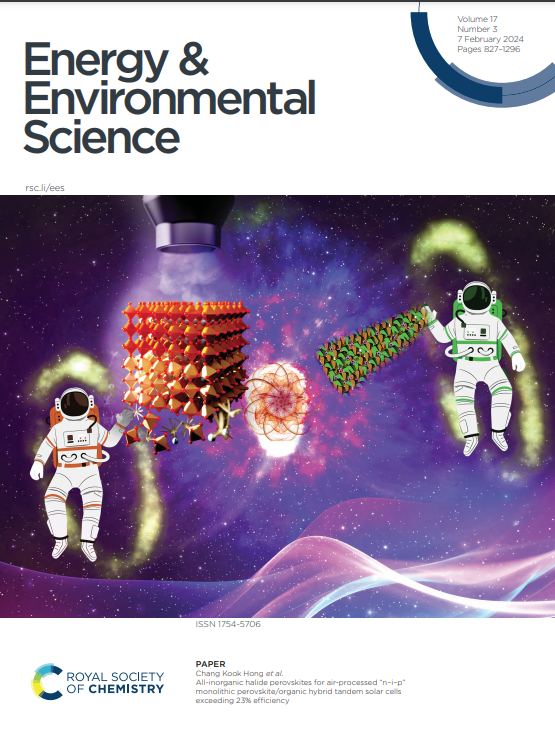Benzannulation of Furan: A Strategy for Stable and High-Performance Furan-containing Giant Electron Acceptor with Efficiency Exceeding 20%
IF 32.4
1区 材料科学
Q1 CHEMISTRY, MULTIDISCIPLINARY
引用次数: 0
Abstract
The use of furan as a building block for electron acceptors in organic solar cells has been limited by its instability, particularly its susceptibility to Diels-Alder cycloaddition with singlet oxygen. In this study, we address the degradation challenges historically associated with furan through a benzannulation strategy, in which one of furan's double bonds is incorporated into an aromatic sextet, rendering the benzenoid aromaticity energetically unfavorable to disrupt via Diels-Alder cycloaddition. We synthesized a benzotrifuran-centered giant electron acceptor (BQx-O) with three Y6 arms, alongside benzotrithiophene (BQx-S) and benzotrisselenophene (BQx-Se) analogues for comparison. Quantum chemical calculations indicate that the BQx-O maintains a near-planar structure, promoting enhanced π-conjugation and molecular packing compared to the more twisted thiophene and selenophene counterparts. As a result, BQx-O achieved an outstanding power conversion efficiency (PCE) of 18.6% in binary OSCs, outperforming BQx-S (14.9%) and BQx-Se (12.6%), and setting a new benchmark for all furan-containing and all giant electron acceptors. In optimized ternary OSCs, BQx-O further reached a remarkable PCE of 20.11%. Moreover, the planar conformation of BQx-O and its reduced diffusion coefficient contribute to superior morphological and operational stability. This study demonstrates benzannulation as a straightforward yet powerful strategy for designing high-performance, photostable furan-containing acceptors, expanding possibilities for innovative electron acceptor designs.呋喃的苯并环制:制备效率超过20%的稳定高性能含呋喃巨电子受体的策略
呋喃作为有机太阳能电池中电子受体的构建块的使用受到其不稳定性的限制,特别是它对单线态氧的Diels-Alder环加成的敏感性。在本研究中,我们通过苯环化策略解决了历史上与呋喃相关的降解挑战,其中呋喃的一个双键被纳入芳六联体,使得苯的芳香性在能量上不利于通过Diels-Alder环加成破坏。我们合成了一个以苯并三氟醚为中心的具有三个Y6臂的巨型电子受体(BQx-O),并与苯并三噻吩(BQx-S)和苯并三硒吩(BQx-Se)类似物进行比较。量子化学计算表明,BQx-O保持近平面结构,与更扭曲的噻吩和硒苯相比,促进了π共轭和分子堆积。结果表明,BQx-O在二元OSCs中的功率转换效率(PCE)为18.6%,优于BQx-S(14.9%)和BQx-Se(12.6%),为所有含呋喃和所有巨型电子受体设定了新的基准。在优化后的三元osc中,BQx-O的PCE进一步达到了20.11%。此外,BQx-O的平面构象及其降低的扩散系数有助于其具有优异的形态和操作稳定性。本研究表明,苯并环化是设计高性能、光稳定的含呋喃受体的一种简单而有力的策略,扩大了创新电子受体设计的可能性。
本文章由计算机程序翻译,如有差异,请以英文原文为准。
求助全文
约1分钟内获得全文
求助全文
来源期刊

Energy & Environmental Science
化学-工程:化工
CiteScore
50.50
自引率
2.20%
发文量
349
审稿时长
2.2 months
期刊介绍:
Energy & Environmental Science, a peer-reviewed scientific journal, publishes original research and review articles covering interdisciplinary topics in the (bio)chemical and (bio)physical sciences, as well as chemical engineering disciplines. Published monthly by the Royal Society of Chemistry (RSC), a not-for-profit publisher, Energy & Environmental Science is recognized as a leading journal. It boasts an impressive impact factor of 8.500 as of 2009, ranking 8th among 140 journals in the category "Chemistry, Multidisciplinary," second among 71 journals in "Energy & Fuels," second among 128 journals in "Engineering, Chemical," and first among 181 scientific journals in "Environmental Sciences."
Energy & Environmental Science publishes various types of articles, including Research Papers (original scientific work), Review Articles, Perspectives, and Minireviews (feature review-type articles of broad interest), Communications (original scientific work of an urgent nature), Opinions (personal, often speculative viewpoints or hypotheses on current topics), and Analysis Articles (in-depth examination of energy-related issues).
 求助内容:
求助内容: 应助结果提醒方式:
应助结果提醒方式:


